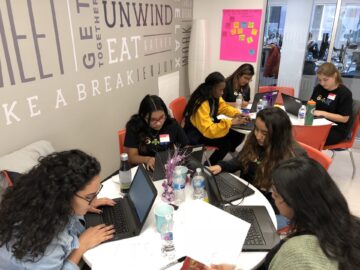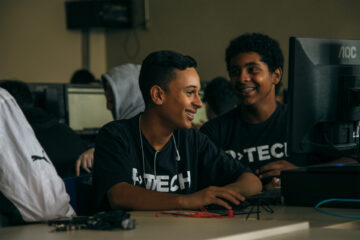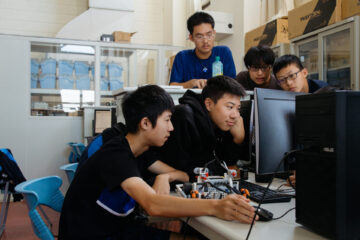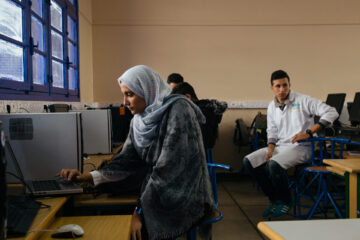P-TECH (Pathways in Technology Early College High Schools) was designed to provide youth in under-resourced systems with an innovative education opportunity that is a direct pathway to college attainment and career readiness. It was developed through a public-private partnership with IBM to enable students to earn both a high school diploma and a no-cost, two-year postsecondary degree in a STEM field.
Spanning grades 9-14, P-TECH provides a holistic approach to education and workforce development. Working at their own pace, students complete a combination of high school and college-level coursework to earn both a high school diploma and associate degree. They also participate in a range of workplace experiences such as mentorships, worksite visits, and paid internships. P-TECH’s ultimate goal is to prepare youth for the estimated 16 million “new collar” jobs that will be created in the US economy by 2024. These jobs will require postsecondary degrees, but not necessarily a four-year college degree.
P-TECH has grown to more than 300 schools worldwide with more than 600 large and small companies serving as partners across a range of sectors, including health IT, advanced manufacturing, and energy technology. P-TECH shares extensive information about its model on its website. P-TECH also supports its model with the digital platform IBM SkillsBuild for Students and Educators (formerly Open P-TECH).
What Makes This Model Innovative?
High Expectations with Unlimited Opportunities
Customization
Active Self-Direction
Goals
In a P-TECH school, students earn a high school diploma and an industry-recognized associate degree while also gaining relevant professional experience in a growing field. P-TECH Skills Mapping In Their Own Words: IBM P-TECH Graduates
Academic Skills
P-TECH students work to meet proficiency benchmarks for taking college courses while also learning how to manage time and tasks, how to study and take tests, and how to handle their stress.
Professional Skills
P-TECH students master the skills and competencies needed for long-term professional success in new-collar jobs in IT, health care, advanced manufacturing, and other competitive fields.
Agency
P-TECH students develop a unique sense of initiative and ownership in their education because they know they are working toward a personally purposeful and relevant outcome: an associate degree.
Experience
 The P-TECH model takes students on a focused journey through an integrated curriculum that prepares them for both academic and workplace paths in their postsecondary lives. This journey is designed to encompass six years, but students can move at their own pace, enabling some to accelerate through the model in as little as four years. Along the way, students engage in a variety of meaningful professional experiences to expose them to the workplace and provide them with opportunities to apply what they are learning in the classroom. The ABC’s of P-TECH P-TECH Scope & Sequence Guide
The P-TECH model takes students on a focused journey through an integrated curriculum that prepares them for both academic and workplace paths in their postsecondary lives. This journey is designed to encompass six years, but students can move at their own pace, enabling some to accelerate through the model in as little as four years. Along the way, students engage in a variety of meaningful professional experiences to expose them to the workplace and provide them with opportunities to apply what they are learning in the classroom. The ABC’s of P-TECH P-TECH Scope & Sequence Guide
 A P-TECH school is not simply four years of high school followed by two years of college. Instead, students advance through their high school and college courses and professional experiences in an integrated fashion.
A P-TECH school is not simply four years of high school followed by two years of college. Instead, students advance through their high school and college courses and professional experiences in an integrated fashion.
Students enter P-TECH schools in grade 9, can begin taking college courses as early as grade 10, and gradually work toward the attainment of an industry-recognized associate degree. The model is primarily focused on English, mathematics, Workplace Learning, and technical courses. While all students enroll in the same sequence of courses, the timing of their progression through the course sequence varies. Students who meet the proficiency benchmarks for taking a college course sooner can move through the program at an accelerated pace and finish in less time, whereas students who need more time to meet the benchmarks receive additional instruction to master the necessary prerequisite concepts.
 Students in a P-TECH school “learn by doing” as much as possible. One way this occurs is through project-based learning (PBL) opportunities in all core academic classes. Projects focus on real-world issues and teach students how to collaborate and solve problems. Teachers play a role more akin to a facilitator in this democratized approach which emphasizes student voice and choice. Project-based academics also help students prepare for professional environments where extensive collaboration and feedback are vital to the success of projects.
Students in a P-TECH school “learn by doing” as much as possible. One way this occurs is through project-based learning (PBL) opportunities in all core academic classes. Projects focus on real-world issues and teach students how to collaborate and solve problems. Teachers play a role more akin to a facilitator in this democratized approach which emphasizes student voice and choice. Project-based academics also help students prepare for professional environments where extensive collaboration and feedback are vital to the success of projects.
Industry partners play a key role in PBL at P-TECH. They work closely with high school and college faculty to design real-world situations to build academic knowledge and develop problem-solving, teamwork, and communication skills that are important in the workplace. Projects also give students opportunities to interact with professionals as they venture into businesses and the community as part of their learning.

The true innovation of the P-TECH model is its comprehensive focus on careers. Industry representatives are integral partners in the development of P-TECH schools and their involvement helps students understand how their coursework, field experiences, and the real-world expectations of the workplace are connected. These connections serve as a motivator and support mechanism that fosters student success.
Workplace learning opportunities provide students with direct exposure to professionals in their chosen field and teach them professional skills that employers value across different industries—Agile, design thinking, leadership, communication, collaboration, analytical thinking, self-management, and cognitive flexibility.
To ensure students graduate career-ready, industry partners provide students with a comprehensive set of focused workplace experiences, worksite visits, mentoring, job shadowing, and skills-based paid internships and apprenticeships. These experiences are not ancillary to the high school and college coursework, but are instead integrated into the P-TECH academic scope and sequence.
- Service Learning: This element of the P-TECH experience provides students an opportunity to offer their services to a community or nonprofit organization that needs support. The goal is for students to learn the importance of citizenship while developing their technical and workplace skills in a real-world environment. Students are not paid for their time, but rather contribute their skills to provide something of use. What is offered is determined and mutually designed by the organization in need and a team of students.
- Mentoring: P-TECH students are matched with professionals in their field of study who act as mentors, modeling behaviors and skills and offering support, guidance, and inspiration. Students may be matched to the same mentors for the entire course of their P-TECH schooling, or have different mentors throughout their experience. Mentoring activities may include participation in school projects, such as hackathons, resume writing workshops, or simple discussions at the school or workplace. P-Tech Mentoring Guide
- Skills-Based Paid Internships: Internships represent a significant milestone for a P-TECH student, signaling that the student is ready—academically and emotionally—to leave the safe haven of the school and take on an actual job assignment in a real workplace. Schools and industry partners create internships that provide educational bridge experiences for students to learn and contribute to the best of their ability. The P-TECH model prepares students for internships through workshops that cover workplace dress and etiquette, resume writing, and “mock” interviews. Students can be placed in internships individually or in groups and asked to produce work in a team setting, which mirrors what many actual employees do. All students are paid by the employer, ensuring that their internships resemble real-world jobs, that their work is of value to the employer, and that they are not deterred from these professional experiences because they need to earn money. P-TECH Internship Program Guide
Supporting Structures
The P-TECH model can be integrated into any high school that can support the six-year program and establish necessary partnerships. P-TECH schools begin with a partnership between at least one school, college, and employer.
The P-TECH model relies on partnerships with colleges and industry to develop curriculum that ensures students graduate career- and college-ready.
To implement the P-TECH model, teachers, working with college instructors and industry professionals, must design a curriculum that helps students understand how their coursework, field experiences, and the real world expectations of the workplace are connected. The curriculum that schools design needs to help all students develop the skills and knowledge they need to graduate high school and earn an associate degree, regardless of their level upon entering the program.
The model is based on open enrollment because P-TECH schools have the explicit goal of providing college and industry access to historically underrepresented students.
P-TECH schools are open to all students, with no grade or testing requirements. Schools interested in the model should recognize that the students who are least likely to complete a college degree are those most in need of early and engaging college experiences. P-TECH schools are designed to bridge this gap and support these students by explicitly acknowledging and responding to their needs.
P-TECH schools enroll and support a diverse group of students, including young people from low-income families, first-generation college students, English language learners, students with disabilities, and students of color. Schools that adopt the model must be prepared to offer customized support for all students.
Because students may be enrolled in high school and college courses simultaneously, faculty who teach in the P-TECH model must be able to work with students across a range of ages.
Because the P-TECH model spans grades 9-14, all faculty must have the preparation necessary to work with high school age students who may also be enrolled in college level courses as early as their sophomore year. Faculty who teach college-credit-bearing courses must have the appropriate credentials, as specified by the college partner. In some cases, a high school teacher may have the credentials to teach college credit courses or courses may be co-taught by college and high school faculty. Typically, however, the college partner hires adjunct professors to teach courses for college credits. Having a college professor come to their high school to teach their class helps students build their identities as college students.
The P-TECH model requires a strong commitment to active collaboration within public-private partnerships.
A P-TECH school relies on developing and sustaining healthy partnerships with and among the school district, college, and one or more local industry. To be successful, schools that adopt the P-TECH model must cultivate and manage partnerships characterized by shared responsibility and decision-making, close collaboration, and honest communication.
P-TECH schools must provide students access to a no-cost postsecondary degree.
To support the achievement of an associate degree, there is no cost for students and their families at P-TECH. To uphold this commitment, it is vital that schools adopting the model ensure adequate funding for ongoing sustainability.
Many states have identified ways to fund the model and ensure high-quality replication. One of these sources is the Carl D. Perkins Act. Recognizing that schools that aim to prepare students for careers often incur additional expenses, states and local school districts can receive Perkins Act funding from the U.S. Department of Education to support Career and Technical Education. P-TECH Funding
The P-TECH model relies on consistent, clear communication between all partners.
The unique structure of the six-year P-TECH model along with its collaboration across multiple partners means that systems for effective communication must also be in place. Families need recruitment information that fully explains the expectations of the extended time commitment as a pathway to an associate degree and career opportunities. Partners need to understand expectations for instruction and mentoring as well as the Workplace Learning experiences they create for students.
The P-TECH model relies on partnerships with colleges and industry to develop curriculum that ensures students graduate career- and college-ready.
To implement the P-TECH model, teachers, working with college instructors and industry professionals, must design a curriculum that helps students understand how their coursework, field experiences, and the real world expectations of the workplace are connected. The curriculum that schools design needs to help all students develop the skills and knowledge they need to graduate high school and earn an associate degree, regardless of their level upon entering the program.
The model is based on open enrollment because P-TECH schools have the explicit goal of providing college and industry access to historically underrepresented students.
P-TECH schools are open to all students, with no grade or testing requirements. Schools interested in the model should recognize that the students who are least likely to complete a college degree are those most in need of early and engaging college experiences. P-TECH schools are designed to bridge this gap and support these students by explicitly acknowledging and responding to their needs.
P-TECH schools enroll and support a diverse group of students, including young people from low-income families, first-generation college students, English language learners, students with disabilities, and students of color. Schools that adopt the model must be prepared to offer customized support for all students.
Because students may be enrolled in high school and college courses simultaneously, faculty who teach in the P-TECH model must be able to work with students across a range of ages.
Because the P-TECH model spans grades 9-14, all faculty must have the preparation necessary to work with high school age students who may also be enrolled in college level courses as early as their sophomore year. Faculty who teach college-credit-bearing courses must have the appropriate credentials, as specified by the college partner. In some cases, a high school teacher may have the credentials to teach college credit courses or courses may be co-taught by college and high school faculty. Typically, however, the college partner hires adjunct professors to teach courses for college credits. Having a college professor come to their high school to teach their class helps students build their identities as college students.
The P-TECH model requires a strong commitment to active collaboration within public-private partnerships.
A P-TECH school relies on developing and sustaining healthy partnerships with and among the school district, college, and one or more local industry. To be successful, schools that adopt the P-TECH model must cultivate and manage partnerships characterized by shared responsibility and decision-making, close collaboration, and honest communication.
P-TECH schools must provide students access to a no-cost postsecondary degree.
To support the achievement of an associate degree, there is no cost for students and their families at P-TECH. To uphold this commitment, it is vital that schools adopting the model ensure adequate funding for ongoing sustainability.
Many states have identified ways to fund the model and ensure high-quality replication. One of these sources is the Carl D. Perkins Act. Recognizing that schools that aim to prepare students for careers often incur additional expenses, states and local school districts can receive Perkins Act funding from the U.S. Department of Education to support Career and Technical Education. P-TECH Funding
The P-TECH model relies on consistent, clear communication between all partners.
The unique structure of the six-year P-TECH model along with its collaboration across multiple partners means that systems for effective communication must also be in place. Families need recruitment information that fully explains the expectations of the extended time commitment as a pathway to an associate degree and career opportunities. Partners need to understand expectations for instruction and mentoring as well as the Workplace Learning experiences they create for students.
Supports Offered
P-TECH offers the following supports to help implement their model.
Teacher Toolkit
Free
IBM SkillsBuild for Students and Educators (formerly Open P-TECH) was created to showcase all of the important resources needed to make the P-TECH model a success in the classroom.
Roadmap
Free
This multiyear roadmap highlights key pieces in the development of a successful P-TECH school and is intended as a general guide. The Roadmap is designed to be used in concert with the P-TECH Blueprint. Successful P-TECH schools customize and enrich activities to fit their specific needs while still maintaining fidelity to the model.
Blueprint
Free
Blueprint is a curated guide of resources to establish, implement, and advance the P-TECH model. Resources provide best practices, templates, and samples to support and foster the growth of a school’s P-TECH program. Assets are organized into seven categories, each detailing specific aspects of the P-TECH model and stakeholder responsibilities.
Reach
Impact
Findings from an evaluation of the first seven New York City P-TECH schools provide encouraging early evidence about the ability of the P-TECH 9-14 schools to prepare students for the transition to college and career.
- P-TECH 9-14 students earned more total credits than students in other schools, with results driven by credit accumulation in career and technical education and other nonacademic subjects. These additional credits did not appear to come at the expense of earning academic credits.
- At the end of two years of high school, 42% of P-TECH 9-14 students had passed the ELA Regents exam with a score qualifying them for enrollment in City University of New York courses, compared with 25% of comparison group students. By the end of three years, the gap was smaller but still favored P-TECH 9-14 students.
- By the end of 10th grade, P-TECH students were statistically significantly more likely to attend high school for more days.
- Paid internships are available in some form at all P-TECH schools, although there is substantial variation in the levels of student participation across schools.
Texas is home to 108 P-TECH school partners, 29 college partners, and 204 industry partners. According to Education Commissioner Mike Morath, P-TECH was responsible for 13% of the total associate degrees earned by the state’s 2020 graduating class.

